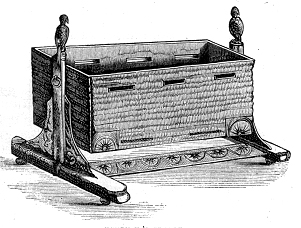|
|
On The Welsh Border.,
Page 13 of 14 lament the losse of glorie then Monmouth’s Castle, which Captive like doth yeeld to conquering Time. Her downe-cast stones from those lofty Turretts doe shew what beautie once it bare, standing mounted round in compasse, and within her walles another mount, whereon a Towre of great height and strength is built, which was the birthplace of our conquering Henry the great triumpher over France, but now decayed, and from a Princely Castle, is become no better then a regardlesse Cottage.”
There are no vestiges of this tower now remaining. It was pulled down by Cromwell’s soldiers. One Sunday, when the people were at church, some months after the place had been taken by the Roundheads, they were startled by the noise of a crash in the castle grounds: the tower had fallen, after long undermining. The stones were carried away soon after to mend the roads. But the oaken cradle in which the hero of Agincourt was rocked when a baby is still in existence, carefully preserved by descendants of a personage who held the responsible office of rocker to the prince. It is wider at one end than at the other, and there are holes at the bottom for cordage to pass through, on which was supported the royal baby’s bed-a mattress of rushes, the best the land afforded.
Monmouth Castle, of which the ruins are uninteresting by comparison with those of Chepstow and Raglan, formed one of the range of fortresses erected by William the Norman immediately after the Conquest, and was held through five centuries by various Norman lords of the border. I should not have lacked for amusement in Monmouth had I arrived in the town a hundred years earlier. Not only had they theatres in the last century, but they had other entertainments, which are now obsolete. They had badger-baiting, bear-baiting, bull-baiting, and cock-fighting galore ; and while the severer moralists condemned “the baiting of the bear and cock-fighting” as “no meet recreations,” they held that “the baiting of the bull hath its use, and therefore it is commended by-the civil authority.” They had still other recreations, which put to shame that lonely, solemn billiard-table. They gathered every evening to play at quoits, fives, tennis, bowls, and archery. When Lord Nelson was here in the summer of 1802, the hero of Trafalgar did not go to bed at ten; on the contrary, he met a merry party at the bowling-green, and passed the evening till a late hour in great jollity. Among the ancient relics of Monmouth there is one which was supposed to be the font at which the illustrious Harry was christened. It is a stoup which was dug up in a garden on that side of the castle nearest the church and its surface is decorated with shields, which would seem to indicate that it was a vessel of some dignity. But the wisest antiquaries think it was the mortar used in the castle kitchen to pound up the mustard. Salt beef and bacon were the common food of the mediæval masses, and mustard the universal condiment eaten therewith. The stoup weighs fifty-six pounds, and is of a common gritstone peculiar to the Forest of Dean, the same which is used for corner-stones in the castle. I am perfectly willing to concede that it is not the baptismal font of the royal Harry, so long as I am left in the undisturbed belief that it was the mustard mortar of his cook; but I am determined to set my face as a flint against this modern crop of sharp-nosed wiseacres who, with cold, glittering, remorseless spectacles, peer into the sweet |
||
|
13
Books & articles appearing here are modified adaptations
from a private collection of vintage books & magazines. Reproduction of these pages is prohibited without written permission. © Laurel O'Donnell, 1996-2006.
|
|||




